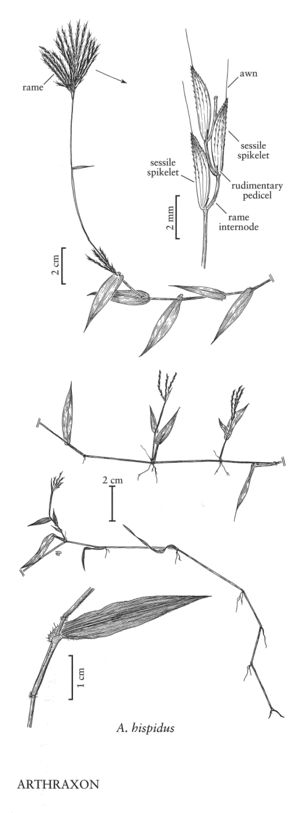| Taxon | Illustrator ⠉ | |
|---|---|---|
 | Arthraxon hispidus | Hana Pazdírková Linda A. Vorobik |
Plants annual or perennial; scrambling. Culms 0.5-2 m, ascending to decumbent, often rooting at the nodes, branched. Leaves not aromatic; sheaths open, at least the outer margins pubescent, usually with papillose-based hairs; ligules membranous, fimbriate or ciliate; blades ovate to ovatelanceolate. Inflorescences terminal and axillary, panicles of subdigitate, often flabellate, clusters of rames; rame internodes not sulcate; disarticulation in the rames, beneath the sessile spikelets. Spikelets in heteromorphic sessile-pedicellate pairs or appearing solitary and sessile, pedicels greatly reduced and lacking spikelets. Sessile spikelets bisexual, with 2 florets; calluses absent or blunt; glumes equal or subequal; lower florets sterile, reduced to an unawned lemma; upper florets bisexual, awned (rarely unawned); anthers 2 or 3. Pedicels 0.2-3 mm, not thickened, not fused to the rame axes. Pedicellate spikelets absent or rudimentary, x = 9, 10.
Distribution
Del., W.Va., Pacific Islands (Hawaii), N.J., N.Y., Fla., Puerto Rico, Tex., La., Tenn., N.C., S.C., Pa., Va., Ind., Ohio, Ala., Miss., Ark., Ill., Ga., Mass., Md., Okla., D.C, Oreg., Mo., Kans., Ky.
Discussion
Arthraxon is a genus of seven species that are native to tropical and subtropical regions of the Eastern Hemisphere; one species is established in the Flora region.
Selected References
Lower Taxa
"decumbent" is not a number.